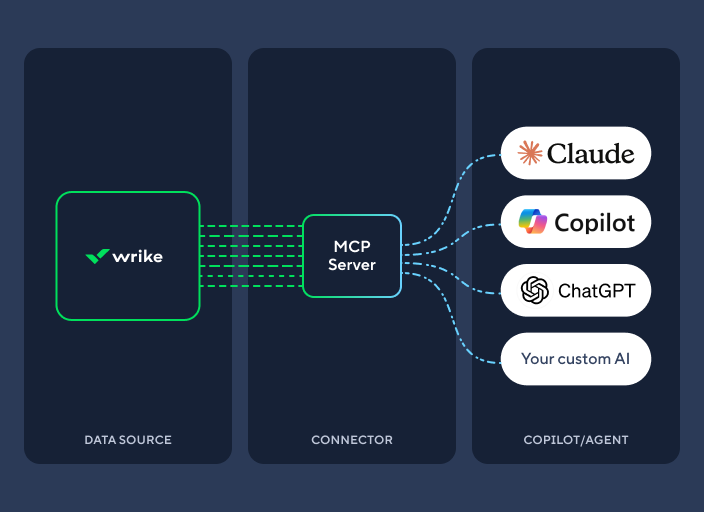Key takeaways:
This blog highlights new data from Wrike showing that while employees are ready to embrace agentic AI, organizations first need to strengthen the foundation of their knowledge, data, and workflows to unlock its full value.
- What concerns do employees have about agentic AI? While interest in agentic AI is high, employees still have concerns — primarily around data accuracy, context, and privacy.
- What data management challenges are facing organizations? Many teams struggle with disorganized knowledge, fragmented systems, and a lack of ownership over documentation and data management.
- How can organizations better prepare for agentic AI? Enable easier access to information, standardized documentation, and consistent capture of project details — all critical to powering more effective AI-driven workflows.
- How can organizations turn AI agents into real productivity drivers? Strengthen documentation, data consolidation, and workflows to give AI agents the context and structure needed to drive meaningful results.
New Wrike data shows that while employees are ready for AI agents, missing context and siloed information prevent intelligent automation.
There’s no shortage of excitement in today’s workplace around agentic AI — the tools designed to operate autonomously, execute tasks, and move projects forward with minimal human input.
While the concept of agentic AI may be new to some, the tools themselves are not. Many employees interact with AI agents regularly, even if they don’t call them that.
According to Wrike’s spring 2025 survey of 1,000 full-time knowledge workers, 64% say they use AI agents provided by their employer, and more than half of them use those tools daily. This suggests that agentic AI may be more widespread — or perhaps more loosely defined — than we think.
Yet as agentic AI gains momentum, the challenges surrounding it are coming into sharper focus. Even the most advanced AI-powered tool can’t operate effectively if it relies on disjointed, inaccurate, or incomplete information. Many organizations still grapple with inconsistent data practices, creating barriers to effective AI deployment.
Without access to high-quality, well-structured proprietary data, AI agents risk becoming more of a burden than a breakthrough. As these solutions continue gaining traction among employees, our data makes one thing clear: Now is the time for organizations to rethink how they manage the knowledge and data powering their operations before they can unlock true value from agentic AI.
Because the secret to smarter AI agents isn’t smarter tech — it’s better context.
Most employees welcome AI agents to their workflows, but trust is lagging
Interest in agentic AI is quickly turning into action, with nearly two-thirds of employees using the AI agents provided by their employers. Among those with access to an AI agent at work, 53% use these tools daily, and another 34% use them weekly, highlighting a clear appetite for automation when the right tools are in place.
The outlook is more skeptical among employees without access to agentic AI: Only 29% say they’d use it daily, and 24% wouldn’t use it at all. But this isn’t necessarily indicating a lack of interest — it’s more likely a reflection of uncertainty.
Whether or not employees currently have access to AI agents, 87% of respondents reported at least one concern about using them at work.
Employees’ top three concerns are that an AI agent will:
- Act on inaccurate or incomplete information (37%)
- Introduce new data privacy concerns (31%)
- Fail to understand the context of their work (28%)
Notably, only 12% of respondents cited concerns about an AI agent’s ability to work well with their team’s current tools and processes. But that doesn’t mean integration is a non-issue.
In fact, when looking at one critical point of connection — the handoff between planning and execution — the gaps quickly become clear. Among respondents with access to both brainstorming/planning tools and task execution tools, only 53% say the two types of tools are “very connected” — meaning ideas and plans flow seamlessly into task management systems with minimal effort.
This points to the broader challenge of fragmented systems that make it harder for AI agents to operate effectively. It’s also why many organizations are turning to Model Context Protocol (MCP) servers. MCP servers securely connect AI agents to real-time work management data like tasks and workflows, giving them the context they need to deliver more relevant and accurate support.

Disorganized data stops teams from tapping into their full knowledge power
Whether it’s operational workflows, historical customer insights, or performance metrics, a company’s knowledge and data fuel every decision across the business. This makes it a critical ingredient for AI success.
|
What data types matter most for AI success? To drive intelligent automation, organizations need access to well-organized knowledge and data. This includes process or operational data (e.g., how tasks are completed or team responsibilities), business rules and logic (e.g., approval flows or decision criteria), customer data (e.g., needs, preferences, account history and details), user interaction data (e.g., how people engage with internal systems and tools), performance metrics (e.g., project outcomes or success metrics), and system and integration data (e.g., how tools connect or how information flows). |
But while 74% of employees say their company treats knowledge and data as valuable assets, only a fraction are managing it in a way that supports AI-readiness.
Case in point: Employees say their organizations have lost critical information over the past year due to several preventable issues — with the top culprit being information scattered across siloed tools and platforms.
Top 5 reasons for knowledge and data loss in the past 12 months:
- Information is scattered across siloed tools and platforms (41%)
- Important documents or messages are being buried in threads and folders (37%)
- People forgetting to document or share important details (36%)
- Employee turnover resulting in loss of institutional knowledge (33%)
- Lacking standards for how or where information should be saved (28%)
One likely reason contributing to these challenges? A lack of ownership.
When asked who’s primarily responsible for capturing knowledge and data at their organization, respondents were split: 24% pointed to project managers, 23% to team or department leads, and 21% to individual employees. Another 23% said it’s a shared responsibility.
Without clear ownership over note-taking and feedback capture, documentation becomes inconsistent and unreliable, giving AI agents nothing solid to act on. Whether through dedicated roles or shared protocols, organizations must establish standardized methods of capturing knowledge to ensure AI tools have accurate, consistent context to work from.
Any AI tool can tap into the same publicly available resources. It’s an organization’s proprietary data — both structured and unstructured — that unlocks true competitive advantage. This unique internal knowledge is the secret ingredient that can elevate AI performance, driving more informed, context-aware outcomes.
AI ambition starts with everyday fixes
AI agents depend on well-organized, accessible information to make smart decisions, streamline tasks, and deliver real value. When teams struggle with disorderly and hard-to-find data, they lack the operational stability required to make the most of AI-powered tools.
Our data shows many teams are still grappling with basic workflow and information management challenges — issues that must be resolved before AI agents can drive meaningful automation.
When asked how their organizations could improve knowledge and data management, employees highlighted practical, day-to-day needs rather than aspirational fixes.
| Top ways employees would improve their organization’s knowledge and data management | |
| No. 1 | Make important information easier to find and access |
| No. 2 | Consolidate information across fewer tools or platforms |
| No. 3 | Standardize how work is documented and shared across teams |
| No. 4 | Ensure key details (e.g., goals, timelines, and feedback) are consistently captured |
| No. 5 | Make information more organized and accessible so AI tools can use it effectively |
Respondents echoed similar themes when it came to AI automation. When asked which workflow bottleneck they’d most like an AI agent to handle, employees prioritized reducing the manual burden of moving data between tools — a challenge rooted in fragmented knowledge management.
Others highlighted the need for AI agents to proactively identify and correct process inefficiencies, as well as help prioritize tasks based on deadlines or impact, reinforcing the desire for automation that alleviates everyday friction.
Employees aren’t looking for AI agents to do everything. They need them to do the right things — the repetitive, tedious tasks that get in the way of more impactful work. But even that requires a solid foundation of clear and connected data.
Help your data reach its full potential. Then AI agents will do the same
AI has created a complex window for innovation. Let’s not pretend otherwise.
At times, it likely feels like there’s so much you can’t control — the pace, quality, and scalability of AI tools can feel out of your hands. But the single biggest element you can control is how well your systems and data are prepared to support AI.
Rather than layering AI tools on top of fragmented processes and inconsistent data, focus on getting the fundamentals right first. That means:
- Improving documentation
- Consolidating and organizing information, with clear ownership
- Creating workflows that preserve context across teams
Managing complex workflows requires solutions that unify data, enforce consistency, and make critical knowledge easy to access across the business. Ultimately, the difference between AI agents that add value and those that add noise boils down to the quality and accessibility of the proprietary data they’re powered by.
Ready to see how Wrike can help you centralize knowledge, streamline workflows, and build a data foundation that’s ready for AI — and AI agents in particular? Get in touch to learn more.
Methodology for “The secret to smarter agentic AI? Deeper context” report
In May 2025, Wrike surveyed 1,000 full-time knowledge workers — defined as employees working either fully in the office, fully at home, in a co-working space, or in a hybrid work setting. At the time of the survey, all respondents were located in the U.S., 18 years or older, and employed at an organization with at least 1,000 employees globally.
FAQs on Agentic AIs
What is an agentic AI?
An AI agent is an autonomous system that plans and executes tasks independently, based on minimal human input that’s typically provided in natural language.
What is an example of an agentic AI?
Organizations are using agentic AI in various ways to streamline operations, enhance productivity, and reduce manual work. One example is Microsoft’s Copilot Studio agents, which can handle multi-step business processes such as initiating approvals, updating records, and triggering follow-up actions across departments.
Other examples include ServiceNow’s customer service agents, which can independently resolve support tickets and handle inquiries, and HubSpot’s prospecting agent, which automatically nurtures leads and advances them through the sales funnel with limited human intervention.
What’s the difference between agentic AI and generative AI?
Generative AI (GenAI) is designed to create new content — such as text, images, or code — in response to user prompts, drawing from patterns in existing data. On the other hand, agentic AI goes a step further and can take action autonomously. Agentic AI can set goals, make decisions, and carry out tasks independently with minimal human input. In short, GenAI generates content while agentic AI independently manages end-to-end tasks.







